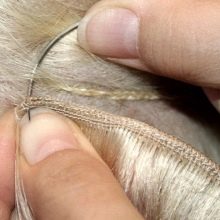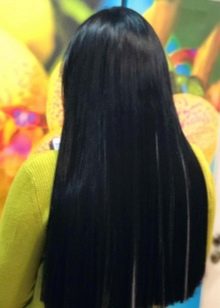Not every girl can boast of long luxurious hair, donated by nature. Fortunately, modern technology allows us to achieve impressive results for every woman. To do this, it is enough to contact a specialized salon and make an extension. All that is required of you is a few hours of free time and money. The main thing is to choose the right technology for this procedure.

Today we will talk about such a proven method as hair extensions on a pigtail. It is also called the tress extension, African, Japanese, French and Hollywood extensions. Thanks to this procedure, you can get a gorgeous hair without the use of aggressive chemical compounds and hot tongs, which is especially important for those who are afraid to spoil their hair.
This technology allows you to grow strands where it is needed: on the back of the head, temples, bangs. According to practitioners, the extension is suitable for hair of any type, structure and color, can be applied even on curly hair.

Features
Braiding hair is done by weaving thin braids at the roots across the back of the head. Then they are sewn tresses - wide ribbons of hair. One such tape is attached to each pigtail. This should be done as close to the root as possible, then the hair will stay in place longer. To adjust the hairstyle, the master washes the client's head, dries and weaves the braids. The main thing is not to braid them in the area where there were pigtails before, otherwise the curls in this place may thinn.




A needle is used to fix the tress on the pigtail. Do not be afraid that the master will accidentally prick your head: for sewing, the so-called sailing needle is used - thick and rounded. Thanks to this design, it enters the hairline and does not touch the skin. Sewing is carried out along the entire length of the braid.



There is an opinion that the piggyback technology came from Africa. Women struggled with naughty curls and began to attach hair bands to the pigtail to get smoother hair.
Despite the simplicity of this method, to build on a pigtail, you need a specialist from the salon or at least an assistant who owns this technique. You can’t do this on your own, as the elements are attached starting from the back of the head.
Moving higher, the master sews a sufficient number of tresses, and then cuts them to the desired length. Narrow locks usually go to the temporal part of the head, and the widest ribbons to the occipital part.
To create a thick head of hair using the braid method, it is desirable to have your hair at least 15 cm long, and can be shorter, but not less than 7 cm. The result obtained lasts 2-3 months.



pros
As mentioned above, this method is called safe. It does not require heat treatment and various chemicals that spoil the structure of the hair, as well as those that can provoke allergies. In addition, the technology has other positive features.
- Supporters of pigtail hair extensions note that thin bases with strands do not cause discomfort to their owners, unlike hair that is attached using the capsule method.
- If necessary, tapes can be easily removed without damaging them. At the same time, you can use tresses repeatedly.
- With such curls you can go to the beach, to the sauna, solarium, use a hairdryer and a curling iron. You can not be afraid that the glue will lose its properties and the locks will fall off, since it is not used with this technology.
- The linings do not change the length during correction, and with careful use they can be worn for months and even years.
- This method is not progressive and highly aesthetic, but at the price it is the most acceptable.


Minuses
Before deciding in favor of this method of building, should take into account some of the disadvantages that accompany the procedure.
- The owner of such hair can not afford all the hairstyles. For example, a high tail will open pigtails and make mounting points noticeable.
- Due to the tight weaving, the first days may be painful. It is believed that wearing tight pigtails with sewn on tresses is no less harmful than using other methods of hair extensions. Therefore, it is hardly possible to call this method the safest for the health of hair.
- Due to the peculiarities of hair attachment and the difficulties with their high-quality combing, tangles can occur.
- Pigtail extension does not allow to harmoniously combine several shades.
- At an average hair growth rate, correction may be required after a month, or even earlier.
- Some people don’t like the fact that hair does not grow in thin locks, but sewn on, which doesn’t look too natural.


Hair choice
To create a lush hair with the help of building on a pigtail, you can use different materials. Natural strands are more expensive, but can achieve a more natural result. Artificial, respectively, are more affordable. In addition, synthetic strands can be painted in bright unusual colors and they do not fade when washed. They also hold their shape well if you decide to initially create corrugated or wound curls.
The leaders among tresses are European ribbons made of natural hair. India and China do not produce such durable products, but they are cheaper. In addition to the quality of the material, the level of the master is no less important for obtaining a good result.

Choose experienced and trusted professionals who have a portfolio about whom they heard positive reviews from friends or Internet users.
Contraindications
They are the same as other types of hair extensions. It is worth refraining from the procedure if:
- psoriasis, seborrhea and other diseases affecting the scalp;
- tendency to baldness;
- weakened, unhealthy hair;
- hormonal imbalance during pregnancy and feeding.


How to care
To make the hairstyle look attractive for as long as possible, you must follow the simple rules of care.
- Before washing your hair, curls need to be combed well. It’s better not to throw your head back, but keep it straight. Use your regular shampoo and balm. Only dry hair products are not recommended, as they contain oils.
- Gently wipe your hair with a towel, do not squeeze it by twisting it with a tourniquet.
- Go to bed only after drying your head.
- It is safest to braid a braid at night - then in a dream you will not damage your hair. You can also put your hair in a regular tail.



Weaving method
There is another way that is often mentioned when it comes to braiding. It is performed differently: the master divides the hair into the smallest strands and draws artificial curls to them at the very roots. Here's how this technology, also called Brazilian, looks step by step.
- All hair is divided into 4 parts - two on top and two on the bottom with a thin long comb. A clip is put on each tail.
- The master begins work with one of the halves of the occipital region, pulling out one strand of 5 mm. He puts on her an artificial strand, folded in half, and wraps it.
- After that, an ordinary thin pigtail of 8 mm is braided.
- The wizard creates a knot from the overhead strand and fixes it with a micro pigtail, or uses a special thread.



This method got its name thanks to the Brazilian women who adorned themselves for the traditional carnival, weaving colored ribbons or hair into the hair. Now it has been adopted by masters from all over the world, and all interested girls can try Brazilian technology on themselves. It allows you to change the length and thickness of the hair or simply decorate yourself for the holiday, adding bright accents to your image with the help of unusual multi-colored strands.


The braid hair extension method has both fans and opponents. For a long time of application, it has established itself as an inexpensive, reliable method in which glues and hot technologies are not used. Perhaps that is why even in our time of constantly improving technologies, he still has many fans.

If you protect your hair from various aggressive influences, do not plan to do high hairstyles or have a predisposition to allergies to various chemical compounds, then you can try this method.
See how the hair extension is done on a pigtail in the next video.










